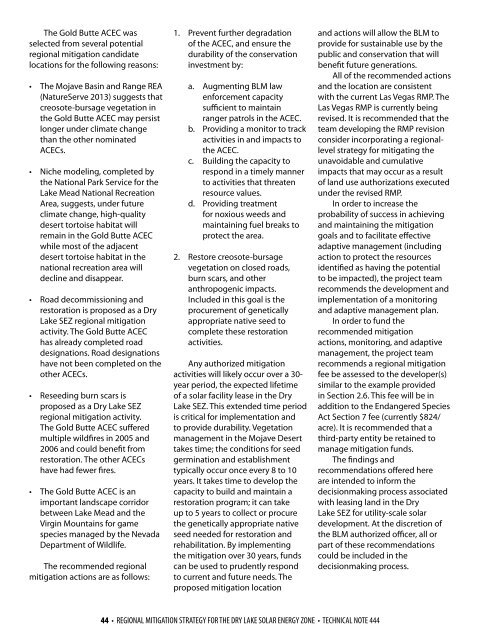xs7hy9e06w?redirect_to=http://www.blm.gov/pgdata/etc/medialib/blm/wo/blm_library/tech_notes.Par.29872.File.dat/TN_444
xs7hy9e06w?redirect_to=http://www.blm.gov/pgdata/etc/medialib/blm/wo/blm_library/tech_notes.Par.29872.File.dat/TN_444
xs7hy9e06w?redirect_to=http://www.blm.gov/pgdata/etc/medialib/blm/wo/blm_library/tech_notes.Par.29872.File.dat/TN_444
You also want an ePaper? Increase the reach of your titles
YUMPU automatically turns print PDFs into web optimized ePapers that Google loves.
The Gold Butte ACEC was<br />
selected from several potential<br />
regional mitigation candi<strong>dat</strong>e<br />
locations for the following reasons:<br />
• The Mojave Basin and Range REA<br />
(NatureServe 2013) suggests that<br />
creosote-bursage vegetation in<br />
the Gold Butte ACEC may persist<br />
longer under climate change<br />
than the other nominated<br />
ACECs.<br />
• Niche modeling, completed by<br />
the National Park Service for the<br />
Lake Mead National Recreation<br />
Area, suggests, under future<br />
climate change, high-quality<br />
desert tortoise habitat will<br />
remain in the Gold Butte ACEC<br />
while most of the adjacent<br />
desert tortoise habitat in the<br />
national recreation area will<br />
decline and disappear.<br />
• Road decommissioning and<br />
restoration is proposed as a Dry<br />
Lake SEZ regional mitigation<br />
activity. The Gold Butte ACEC<br />
has already completed road<br />
designations. Road designations<br />
have not been completed on the<br />
other ACECs.<br />
• Reseeding burn scars is<br />
proposed as a Dry Lake SEZ<br />
regional mitigation activity.<br />
The Gold Butte ACEC suffered<br />
multiple wildfires in 2005 and<br />
2006 and could benefit from<br />
restoration. The other ACECs<br />
have had fewer fires.<br />
• The Gold Butte ACEC is an<br />
important landscape corridor<br />
between Lake Mead and the<br />
Virgin Mountains for game<br />
species managed by the Nevada<br />
Department of Wildlife.<br />
The recommended regional<br />
mitigation actions are as follows:<br />
1. Prevent further degra<strong>dat</strong>ion<br />
of the ACEC, and ensure the<br />
durability of the conservation<br />
investment by:<br />
a. Augmenting BLM law<br />
enforcement capacity<br />
sufficient to maintain<br />
ranger patrols in the ACEC.<br />
b. Providing a monitor to track<br />
activities in and impacts to<br />
the ACEC.<br />
c. Building the capacity to<br />
respond in a timely manner<br />
to activities that threaten<br />
resource values.<br />
d. Providing treatment<br />
for noxious weeds and<br />
maintaining fuel breaks to<br />
protect the area.<br />
2. Restore creosote-bursage<br />
vegetation on closed roads,<br />
burn scars, and other<br />
anthropogenic impacts.<br />
Included in this goal is the<br />
procurement of genetically<br />
appropriate native seed to<br />
complete these restoration<br />
activities.<br />
Any authorized mitigation<br />
activities will likely occur over a 30-<br />
year period, the expected lifetime<br />
of a solar facility lease in the Dry<br />
Lake SEZ. This extended time period<br />
is critical for implementation and<br />
to provide durability. Vegetation<br />
management in the Mojave Desert<br />
takes time; the conditions for seed<br />
germination and establishment<br />
typically occur once every 8 to 10<br />
years. It takes time to develop the<br />
capacity to build and maintain a<br />
restoration program; it can take<br />
up to 5 years to collect or procure<br />
the genetically appropriate native<br />
seed needed for restoration and<br />
rehabilitation. By implementing<br />
the mitigation over 30 years, funds<br />
can be used to prudently respond<br />
to current and future needs. The<br />
proposed mitigation location<br />
and actions will allow the BLM to<br />
provide for sustainable use by the<br />
public and conservation that will<br />
benefit future generations.<br />
All of the recommended actions<br />
and the location are consistent<br />
with the current Las Vegas RMP. The<br />
Las Vegas RMP is currently being<br />
revised. It is recommended that the<br />
team developing the RMP revision<br />
consider incorporating a regionallevel<br />
strategy for mitigating the<br />
unavoidable and cumulative<br />
impacts that may occur as a result<br />
of land use authorizations executed<br />
under the revised RMP.<br />
In order to increase the<br />
probability of success in achieving<br />
and maintaining the mitigation<br />
goals and to facilitate effective<br />
adaptive management (including<br />
action to protect the resources<br />
identified as having the potential<br />
to be impacted), the project team<br />
recommends the development and<br />
implementation of a monitoring<br />
and adaptive management plan.<br />
In order to fund the<br />
recommended mitigation<br />
actions, monitoring, and adaptive<br />
management, the project team<br />
recommends a regional mitigation<br />
fee be assessed to the developer(s)<br />
similar to the example provided<br />
in Section 2.6. This fee will be in<br />
addition to the Endangered Species<br />
Act Section 7 fee (currently $824/<br />
acre). It is recommended that a<br />
third-party entity be retained to<br />
manage mitigation funds.<br />
The findings and<br />
recommen<strong>dat</strong>ions offered here<br />
are intended to inform the<br />
decisionmaking process associated<br />
with leasing land in the Dry<br />
Lake SEZ for utility-scale solar<br />
development. At the discretion of<br />
the BLM authorized officer, all or<br />
part of these recommen<strong>dat</strong>ions<br />
could be included in the<br />
decisionmaking process.<br />
44 • REGIONAL MITIGATION STRATEGY FOR THE DRY LAKE SOLAR ENERGY ZONE • TECHNICAL NOTE <strong>444</strong>


